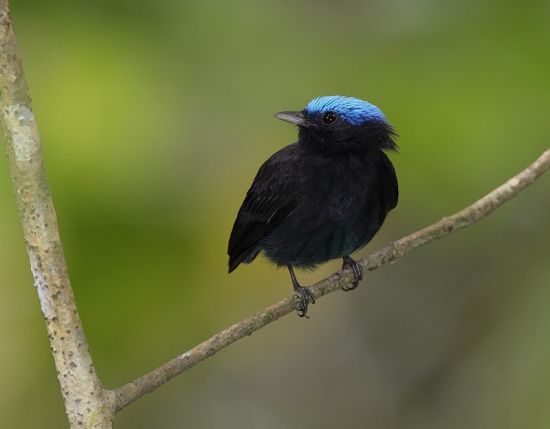
Photo © by anselmo d affonseca
Serra do Tepequem, Amajari, Roraima, Brazil, July 29, 2012
- Lepidothrix coronata
Identification
8–9 cm (3-3½ in)
A typical short-tailed manakin in shape and behavior.
- Iris brownish-red
- Mandible is blackish on upper and light grey on lower mandible
Male coronata type
- Crown bright blue
- Overall plumage black (often of a dull quality)
- Blue wash on lower back/rump
Male exquisita type
- Crown pale blue
- Upperside, throat, and breast dark green
- Belly is yellow
Female
- Overall medium to dark green (often almost bluish-green)
- Belly pale
- Chin, throat, and side of head pale
Variation
The coronata types are essentially constituted by the first three subspecies, ranging from northern South America to northern Peru, while the exquisita type consists of the remaining three subspecies, from Peru to Bolivia and adjacent Brazil. These two forms seems to be interbreeding where they come into contact, and there is no consistent difference in voice.
Distribution
Colombia, Venezuela, Brazil, Ecuador, Peru, and Bolivia. In all areas found east of the Andes.
Taxonomy
This species has in the past been placed in genus Pipra. Velvety Manakin and this species were formerly considered the same species under the name of Blue-crowned Manakin.
Subspecies
Six subspecies are recognized[1]:
- L. c. caquetae:
- Tropical south-eastern Colombia (east of Andes in western Meta and western Caquetá)
- L. c. carbonata:
- L. c. coronata:
- L. c. exquisita:
- Tropical eastern Peru (southern Loreto to Junín)
- L. c. caelestipileata:
- L. c. regalis:
- Tropical northern Bolivia south to Cochabamba
Habitat
Humid tropical forest, and mature secondary forest. observed at heights around 130m, though can occur up to 1400 m.
Behaviour
Males seems to display within their own territory rather than flock at a lekking site.
Diet
Their main diet consists of small fruits and insects, collected in hovering flight. They join mixed species foraging parties.
Vocalisation
The most frequent call is described as a "swee" sound, a rising whistle which may be given singly or as a series. Up to five other vocalizations have been described.
References
- Clements, J. F., T. S. Schulenberg, M. J. Iliff, T. A. Fredericks, J. A. Gerbracht, D. Lepage, S. M. Billerman, B. L. Sullivan, and C. L. Wood. 2022. The eBird/Clements checklist of Birds of the World: v2022. Downloaded from https://www.birds.cornell.edu/clementschecklist/download/
- Gill, F, D Donsker, and P Rasmussen (Eds). 2023. IOC World Bird List (v 13.1)_red. Doi 10.14344/IOC.ML.13.1. http://www.worldbirdnames.org/
- Snow, D. and G. M. Kirwan (2022). Blue-capped Manakin (Lepidothrix coronata), version 1.1. In Birds of the World (S. M. Billerman, Editor). Cornell Lab of Ornithology, Ithaca, NY, USA. https://doi.org/10.2173/bow.blcman1.01.1
Recommended Citation
- BirdForum Opus contributors. (2025) Blue-capped Manakin. In: BirdForum, the forum for wild birds and birding. Retrieved 13 May 2025 from https://www.birdforum.net/opus/Blue-capped_Manakin
External Links
GSearch checked for 2020 platform.1




